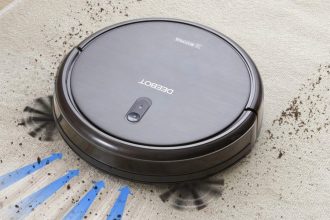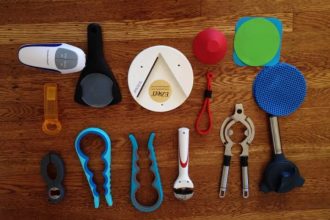This blog post will explain how a food processor works. The food processor is an amazing kitchen appliance that can simplify cooking and baking by chopping, slicing, kneading, pureeing, and more. It can be used in many different recipes to speed up the process of cooking or baking so you don’t have to do all of the work yourself! The following information will go into detail about what each part of this machine does so you know exactly how it works! If you want to learn more about this helpful appliance read on.
How Does a Food Processor Work?
Food processors use sharp metal blades to cut through food with incredible force. In this way, they can quickly and easily chop even the toughest ingredients into tiny pieces. Many models of food processors include multiple blades so that they can perform different functions on one ingredient at once. A paddle often sits below the food being processed so that it stays securely in place as it is chopped up from above. The amount of force applied by a food processor’s blade depends partly on the size of the appliance itself, with larger units applying more power than smaller ones. However, some models also have adjustable speeds which allow you to choose how much power is necessary for each task, making them suitable for almost any type of ingredient or meal.
Food processors are designed to help save time in the kitchen by performing repetitive, tedious tasks quickly and easily. Thanks to their amazing blades, food processors can chop ingredients into small pieces without spilling or wasting very much of your product.
What Is The Correct Way Of Using A Food Processor?
Using a food processor is easy and only takes a few minutes! To start, simply choose your ingredients and remove any peelings or inedible parts. Then place the items into the bowl of the food processor with the top on tightly. If you’re using multiple blades to chop up different types of food, make sure that each one sits at the bottom of the bowl (or on top if there isn’t enough room).
The next step is to attach an appropriate lid to keep all particles safely contained inside. Most lids will twist directly onto the base, but it’s important to check for this feature before purchasing a new food processor just to be safe. Once this crucial step is complete, plug your appliance into an outlet and turn it on.
If you have a model with multiple speeds, start on the lowest one and increase it as necessary until your desired texture is achieved. Alternatively, you can use pre-set buttons for specific textures like “fine” or “coarse.” Once you’ve processed an ingredient enough to achieve the right consistency, remove it from the food processor’s bowl and continue cooking according to your recipe.
Be sure to clean your food processor frequently by removing all parts that can be taken apart (such as bowls and blades) and running them through hot water with liquid soap. Rinse each piece thoroughly before reattaching them back onto the base of the appliance or putting them away in storage. This will help keep your device running smoothly over time!
When Should I Replace A Food Processor?
As with any appliance, a food processor will suffer from normal wear and tear over time. Eventually, its blades may become dull or bent so that they can no longer chop ingredients as well as they used to. If you notice this occurring, it’s time to replace your food processor! You should also replace your device if you’ve dropped it several times, if the lid has become stuck in place, or if there are any other signs of damage. While most models last for years without needing replacement parts or repairs, keeping an eye on the condition of your device is important for safety reasons.
If you treat your appliance well and perform routine maintenance to keep it running smoothly at all times, you’ll be able to use your food processor for years to come!
What Are The Different Things That A Food Processor Can Do?
There are many designs for this machine, and each of them varies in either the number of attachments included accessories for storage, and type of motor used; some parts can be interchangeable between models with similar functions. The most common food processor attachment is a metal blade, shaped like a flat disk with sharpened edges on the perimeter. Less common attachments include dough hooks and pureeing/mixing blades that can handle liquids as well as solids. Food processors are commonly used to blend, mix, chop, grind, and perform many other functions on various food items including vegetables and meats.
Food processors use sharp metal blades to cut through food with incredible force. In this way, they can quickly chop even the toughest ingredients into tiny pieces. Many models of food processors include multiple blades so that they can perform different functions on one ingredient at once. A paddle often sits below the food being processed so that it stays securely in place as it is chopped up from above. The amount of force applied by a food processor’s blade depends partly on the size of the appliance itself, with larger units applying more power than smaller ones. However, some models also have adjustable speeds which allow you to choose how much power is necessary for each task, making them suitable for almost any type of meal or ingredient.”
Frequently Asked Questions
1. Are There Different Types Of Food Processors?
Food processors come in a wide variety of shapes and sizes. They typically have a base, a bowl on top of the base, and a cover to go over everything. The “spatula” on the bottom of the bowl is called a “paddle”, and its purpose is to force whatever it is that you’re processing down into the blade as you process it. This helps to ensure that the blade has no trouble chopping up your ingredients as they drop into it from above. Food processors can vary widely in their blades, too, from those with only one or two interchangeable blades to those that come with multiple attachments for doing different things (such as cutting dough and making ice cream). They also vary in the way that power is applied to them– some have a long shaft with rubber feet for spinning blades on top, while others are “plunger” style where you push down on what’s inside to make it a spin.
2. What Is The Best Way To Use A Food Processor?
Most people agree that using a food processor is pretty simple: place your ingredients inside and press or push them down towards the blade while holding the lid firmly in place. Some foods require the assistance of a spatula to push them down, which is what people often mistake for the blade itself. The matter of concern here is how much pressure you use when pushing things into the blades– this determines how quickly and easily your ingredients will be chopped up.
You should always follow your food processor’s instructions about adding ingredients (how many, in what order) since these machines are designed to work with specific recipes where every ingredient serves a very important function in terms of taste or texture. For example, if carrots are added after onions in your recipe for soup, they’ll never get finely chopped enough because there simply isn’t enough time left before it’s all processed to properly break down their stringy. This means that using pre-made soup mixes (or making your own) is better than attempting to make soup directly in the food processor.
3. What Are Some Common Types Of Food Processors?
Food processors come in different shapes, sizes, and power functions depending on what you’re using it for. They can be either plunger-style or top-mounted; there are “mini” models that are designed to fit into small spaces like kitchens with limited counter space, or double bowl versions where ingredients go into one half first and then get pushed down onto blades in the second half for processing. Some have interchangeable blades so that they can chop things up finely enough for baking needs, while others have sharp steel blades meant only for chopping/grinding needs. The more expensive ones may even have a special function for kneading dough so that bakers don’t need to buy a separate mixer.
4. What Is The Best Food Processor On The Market?
There are many different types of food processors available, depending on which functions you’re looking for, what size you want it to be, and how much money you’re willing to spend. You can easily get overwhelmed when trying to choose between all of the options available online because there’s considerably more information available than there was twenty years ago when this product first debuted. For instance, if you already own a mixer with a number of attachments but find yourself making your own bread crumbs or pureeing things more often these days, then consider purchasing an attachment instead of a whole new machine. Not only is this cheaper, but it won’t take up as much space on your counter/in your cupboards either.
Additionally, if you’re trying to choose between two different models and don’t care about the price difference, go for the more expensive one with interchangeable blades. This means that not only will your food processor be able to process larger chunks of food in a shorter time period (a must-have for people who need to make large batches of salsa or puree potatoes before cooking), but it can also handle any smaller needs like making bread crumbs because there are other blades available for exactly those purposes.
Conclusion
If you want to be successful in your food business, it’s important that you know how a food processor works. A lot of people don’t realize the power and versatility of this kitchen appliance until they’ve used one for themselves. From chopping vegetables to kneading dough, there are so many reasons why owning a food processor can benefit any home cook or professional chef! For more information on all things appliances please visit our blog at. Thanks for reading!







